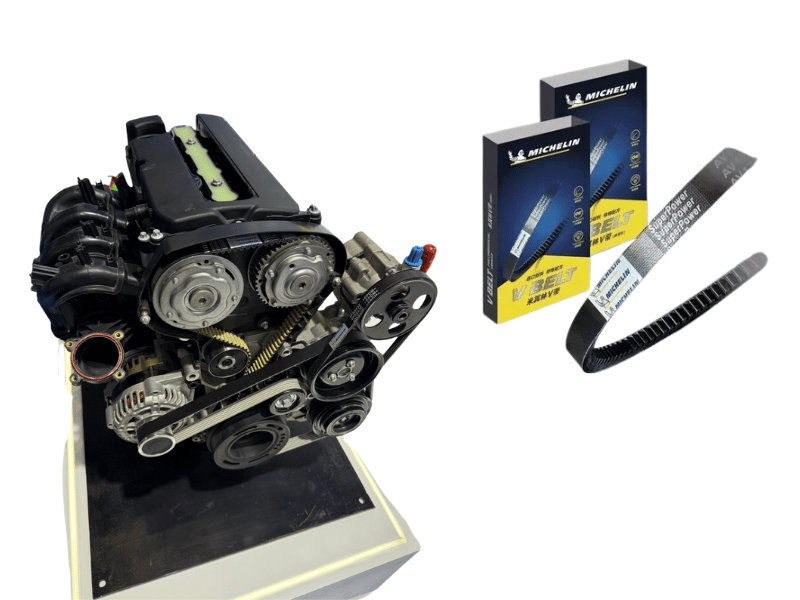
Signs Your Car Engine Belt Needs Replacement: A Complete Guide
Your car's engine belt, whether a serpentine belt, timing belt, or V-belt, is a critical component that keeps essential engine parts functioning smoothly. Recognizing early signs of wear or damage can help avoid costly repairs or breakdowns. Here’s an in-depth guide to the key indicators that your engine belt needs replacement and why proactive maintenance is crucial.
Types of Car Engine Belts
Before diving into the signs of failure, it’s important to understand the main types of engine belts:
- Serpentine Belt: Powers multiple components like the alternator, power steering pump, air conditioning compressor, and water pump.
- Timing Belt: Synchronizes the crankshaft and camshaft, ensuring proper engine timing.
- V-Belt: Typically found in older vehicles, used to drive individual components.
Each belt type plays a unique role in the vehicle’s operation, and failure can lead to serious mechanical issues.
Signs Your Car Engine Belt Needs Replacement
1. Squealing or Chirping Noises
If you hear a high-pitched squealing noise when you start the engine, accelerate, or turn on the air conditioning, it’s a strong indicator of a problem with the engine belt. This noise can be caused by:
- Loose Belt Tension: Over time, belts can stretch or tensioners can weaken, causing slippage.
- Worn Pulley: A damaged or misaligned pulley can cause the belt to slip.
- Moisture or Oil Contamination: Any fluids leaking onto the belt can reduce friction, leading to slippage and noise.
Ignoring this sign can lead to belt failure, which might disable multiple engine components.
2. Cracks, Fraying, or Glazing
Regular visual inspection is essential. Look for the following signs of wear:
- Cracks: Small cracks on the belt surface indicate aging and brittleness, especially in serpentine belts.
- Fraying: Edges of the belt unraveling suggest misalignment or physical damage.
- Glazing: A shiny, smooth surface indicates the belt is slipping and overheating.
These physical signs mean the belt is losing its structural integrity and should be replaced promptly.
3. Engine Overheating
A failing serpentine belt or timing belt can impair the operation of the water pump, which is essential for cooling the engine. Symptoms include:
• The temperature gauge rising into the red zone.
• Steam coming from the engine bay.
Prolonged overheating can cause severe engine damage, such as warped heads or a blown gasket. Immediate inspection and repair are necessary.
4. Loss of Power Steering
If your steering wheel becomes suddenly hard to turn, the serpentine belt could be slipping or broken. The serpentine belt powers the power steering pump, and any failure can affect the steering system, especially at low speeds.
Warning Signs:
- Difficulty steering during turns.
- Groaning or whining noise when turning the wheel.
This issue can compromise vehicle safety, making immediate attention critical.
5. Battery Warning Light or Electrical Failures
A failing serpentine belt can prevent the alternator from charging the battery properly, triggering the battery warning light on your dashboard. Consequences of a malfunctioning alternator belt include:
- Dim headlights or interior lights.
- Frequent battery drain or inability to start the engine.
- Electrical systems (radio, power windows, AC) not functioning properly.
This can leave you stranded if the belt breaks entirely.
6. Vibrations or Wobbling Belts
If you notice the belt wobbling or vibrating excessively while the engine is running, it could be due to:
- Misaligned Pulleys: Pulleys that are out of alignment cause uneven wear and stress.
- Worn Tensioners: Failing tensioners can’t maintain proper tension, leading to instability.
Left unaddressed, these vibrations can lead to belt slippage or snapping.
7. Visible Damage to Pulleys or Tensioners
Check the pulleys and tensioners for signs of wear, such as:
- Rusted Pulleys: Corrosion can cause irregularities that damage the belt.
- Damaged Bearings: Worn bearings in the pulleys can cause noise and uneven rotation.
- Broken Tensioners: If the tensioner isn’t holding the belt tight, the belt won’t operate correctly.
When to Replace Your Engine Belt
- Serpentine Belts: Every 60,000 to 100,000 kilometers (37,000 to 62,000 miles) or as specified by your vehicle manufacturer.
- Timing Belts: Typically replaced every 100,000 kilometers (62,000 miles), but intervals vary by vehicle make and model.
Regular inspections during oil changes or routine maintenance can help catch issues early.
Importance of Quality Engine Belts
Choosing high-quality engine belts ensures reliability, performance, and safety. At Shin-Ho International Trade Co., Ltd., we offer premium Michelin engine belts known for:
- Superior Wear Resistance: Long-lasting performance under high loads.
- Low Noise Operation: Smooth and quiet functioning for enhanced driving comfort.
- High-Quality Materials: Advanced materials like EPDM and HNBR ensure durability in extreme conditions.
We are committed to supplying top-quality belts that meet the needs of automotive manufacturers and distributors worldwide.
Conclusion
Engine belts are critical to your vehicle's operation, and timely replacement can prevent costly breakdowns. By recognizing the signs of wear early, you can keep your engine running smoothly and efficiently. For reliable, high-performance engine belts, trust Shin-Ho International Trade Co., Ltd..
For more information or to discuss your needs, visit our website or contact us today.